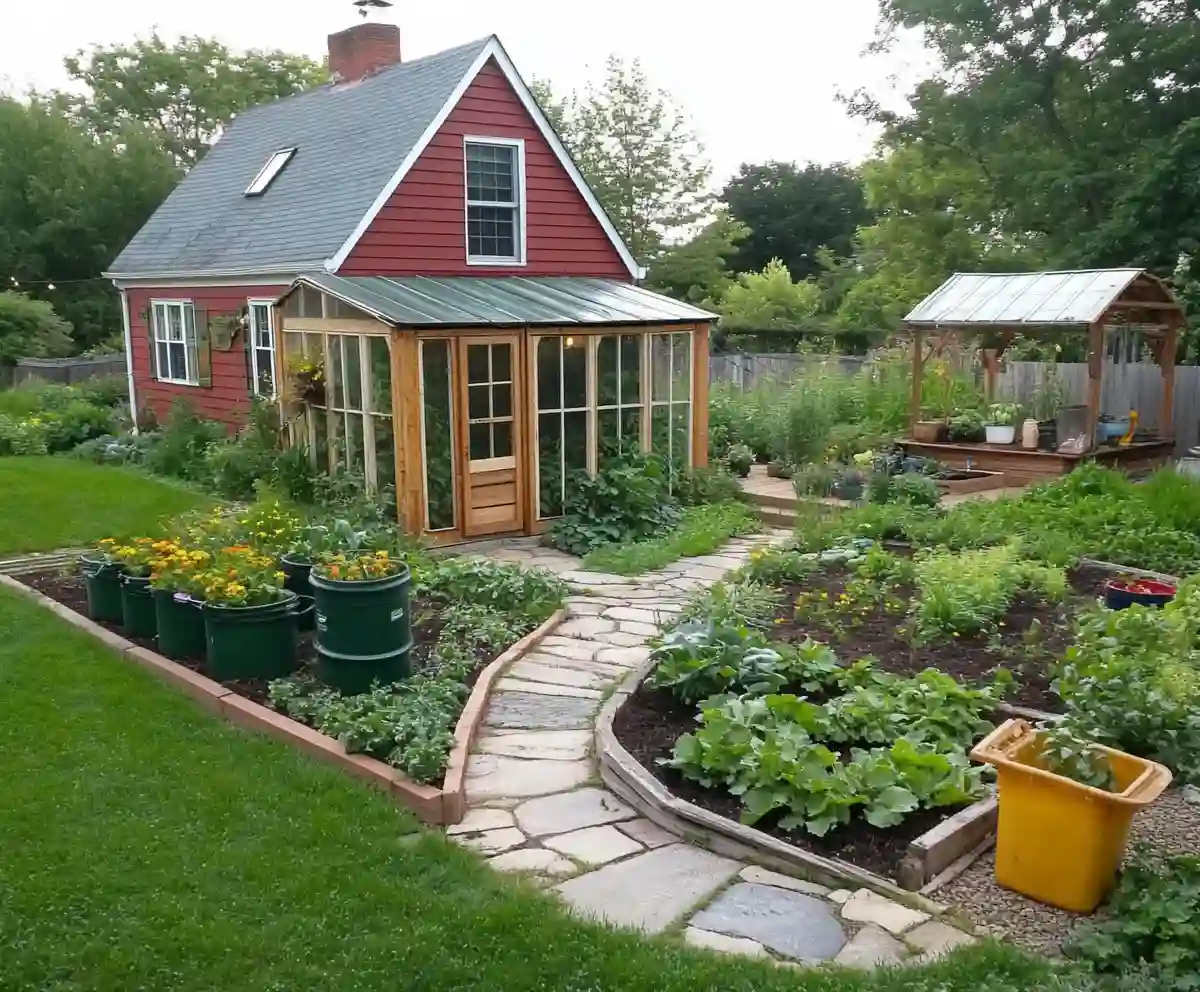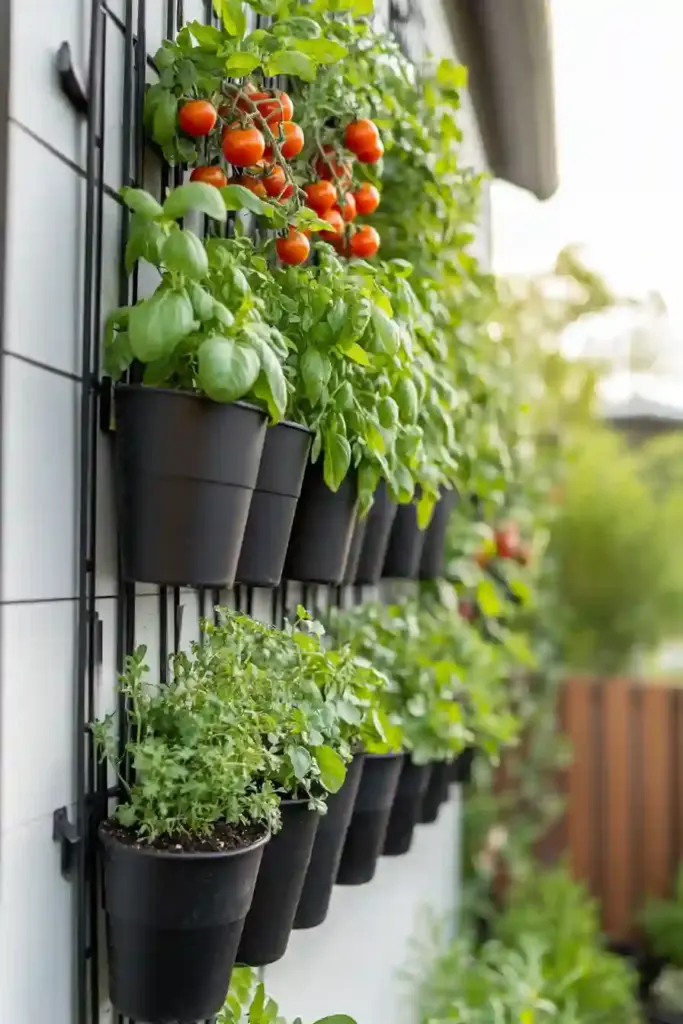Thinking about turning your backyard into a mini-farm? Whether you’ve got a spacious lawn or a cozy patio, backyard farming is a powerful way to grow fresh produce, reduce grocery bills, and live more sustainably. With some smart planning and a bit of creativity, you can transform even the smallest outdoor spaces into high-yield food gardens.
In this guide, we’ll show you how to design a functional and beautiful backyard farm that fits your space and lifestyle. From vertical gardens and compact livestock to DIY projects and seasonal tips, every section is crafted to help you build a thriving, small-scale homestead.
Why Backyard Farming Is Gaining Popularity
Backyard farming blends self-sufficiency with sustainability. In fact, over one-third of U.S. households now grow some type of edible plant. The reasons are clear: rising food costs, environmental awareness, and a growing desire for healthier, homegrown food.
Even a 10×10 foot patch of land can yield an impressive harvest if used wisely. A single chicken, for example, can produce around 200 eggs per year. With techniques like vertical gardening and container planting, your small yard can deliver big results.
Smart Growing: Vertical and Container Gardening for Small Spaces
If space is tight, think up instead of out. Vertical and container gardening techniques allow you to grow a wide range of fruits, vegetables, and herbs without taking up much ground space. These methods are perfect for balconies, patios, and small backyards—and they’re as beautiful as they are functional.
Vertical Gardening: Use Walls, Fences, and Trellises
Vertical gardening is one of the easiest ways to multiply your growing space.
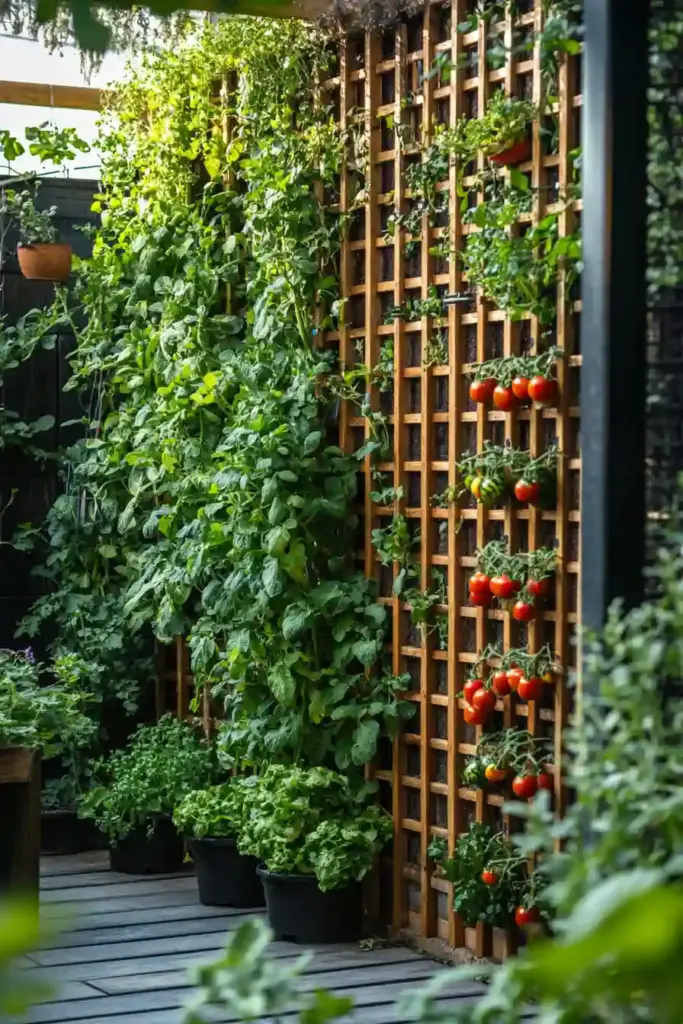
- Trellises and Arbors: Train climbing crops like pole beans, peas, cucumbers, and even tomatoes on vertical structures.
- Wall Planters: Use fabric pockets or hanging pots to grow salad greens, strawberries, and herbs.
- DIY Plant Towers: Stack planters or build towers from repurposed materials to grow lettuce, spinach, or flowers in layers.
💡 Pro Tip: A 4×4 foot trellis can support over a dozen tomato plants and yield 40+ pounds of produce!
Container Gardening: Flexibility and Mobility
Containers are ideal when you want full control over soil, water, and sunlight.
- What to Grow: Peppers, dwarf tomatoes, leafy greens, carrots, and even citrus trees can thrive in pots.
- Container Ideas: Use 5-gallon buckets, wooden crates, window boxes, or even old wheelbarrows.
- Tips for Success:
- Drill drainage holes to prevent soggy roots.
- Use quality potting mix and refresh it each season.
- Raise containers on wheels or platforms for easy sunlight tracking.
Microgreens and Sprouts: Fast, Nutrient-Rich Harvests
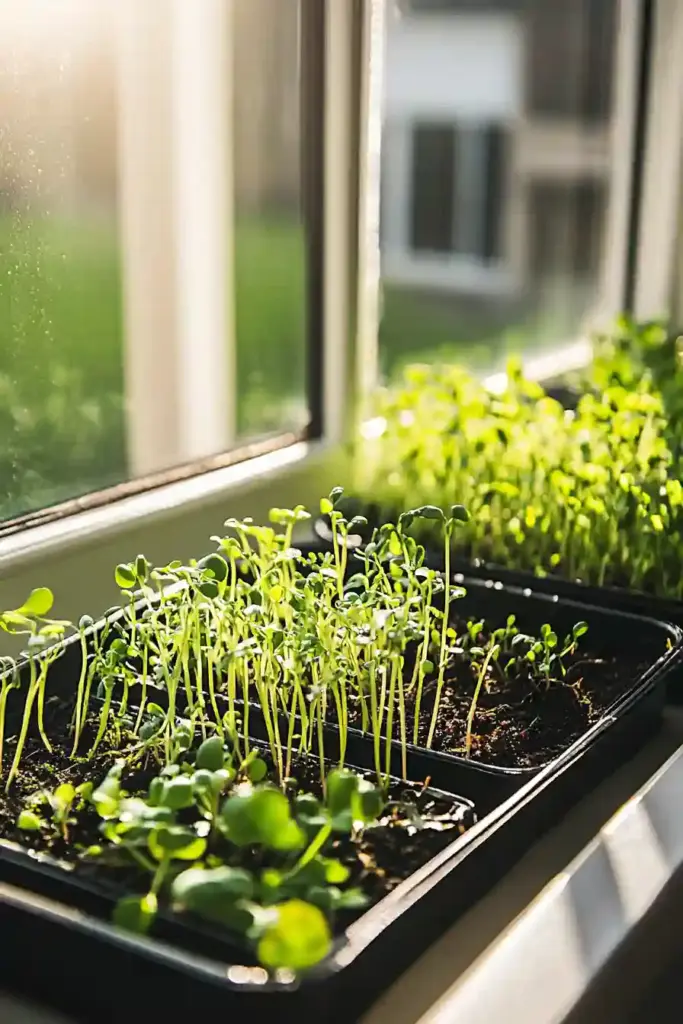
If you’re short on time or space, microgreens are your best friend. These baby greens grow in shallow trays on windowsills or countertops and are ready to harvest in as little as 7 days.
- Try sunflower shoots, radish sprouts, or broccoli microgreens.
- Mist daily and harvest when leaves are about 2-3 inches tall.
- Bonus: They’re packed with nutrients and flavor!
Compact Livestock and DIY Systems: Boosting Backyard Productivity
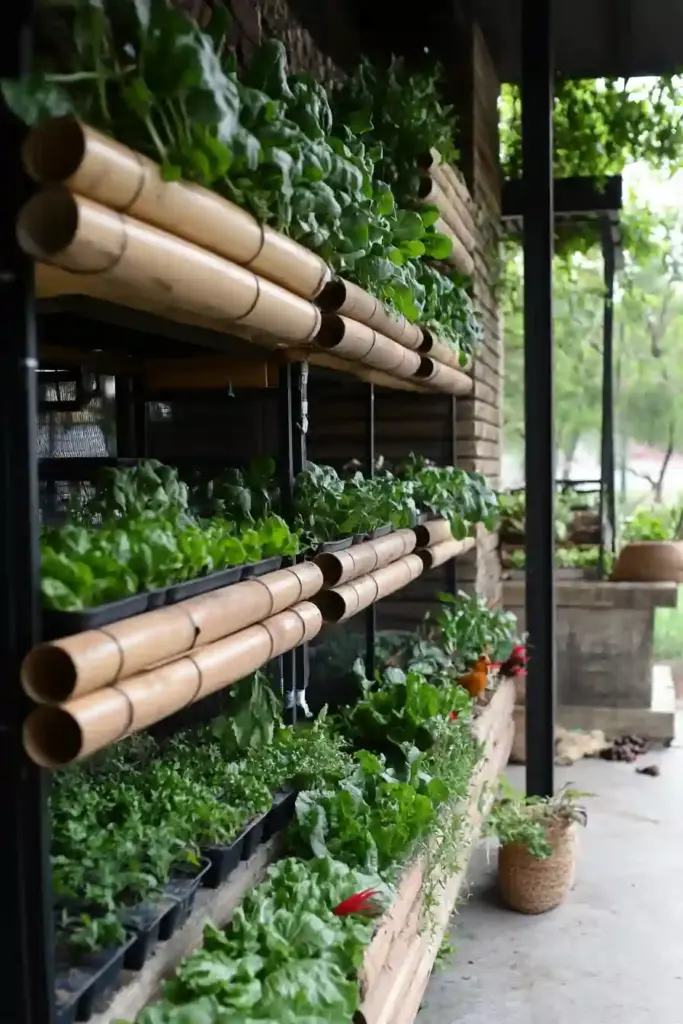
Backyard farming isn’t just about vegetables. Small-scale livestock and alternative growing systems can dramatically increase your harvest and make your homestead more self-reliant—even in limited space.
Mini Livestock: Big Returns in Small Spaces
You don’t need acres of land to raise animals. Many small species are perfectly suited for suburban yards or even urban settings (just check local ordinances first!).
- Quail: Just three hens in a 2×2 foot hutch can lay close to 300 eggs per year. They’re quiet, clean, and legal in many cities where chickens aren’t.
- Chickens: A small flock of 4–6 hens can provide hundreds of eggs annually. Coop designs can be compact, mobile, and even stylish.
- Rabbits: These quiet animals thrive in “tractor pens” that can be moved across lawns. They produce lean meat and excellent manure.
- Bonus Ideas: Consider ducks (great for slug control and eggs) or bees (for pollination and honey).
🐔 Pro Tip: Always provide shelter, clean water, and shade for your animals—and integrate them into your composting or fertilizing system where possible.
DIY Hydroponics: Grow Without Soil
Hydroponics is a game-changer for gardeners with limited soil or space. It uses nutrient-rich water to grow plants faster and more efficiently.
- Simple Setup: PVC pipes, buckets, and an air pump are all you need to build a basic system.
- What to Grow: Leafy greens like kale, lettuce, spinach, and herbs perform especially well.
- Benefits:
- Up to 30% faster growth than soil.
- Water-efficient and mess-free.
- Ideal for patios, greenhouses, or garages with grow lights.
Aquaponics: Fish + Plants = A Self-Sustaining Ecosystem
If you’re ready for a next-level project, aquaponics combines fish farming with hydroponics.
- Fish waste feeds the plants, and the plant roots filter water for the fish.
- Ideal for repurposing old fish tanks or barrels.
- Works well for greens, basil, and even cherry tomatoes.
💧 Pro Tip: Start small—a $20 hydroponic rig or upcycled tank setup is enough to test the waters before scaling up.
Backyard Farming Layout & Design: Plan Smart, Grow More
A well-designed layout is the backbone of a productive backyard farm. By organizing your space into zones, tracking sunlight, and planning for accessibility, you can make every square foot count while keeping things tidy and visually appealing.
Zone Your Space: Form Follows Function
Divide your backyard into key zones to keep your homestead organized and efficient:
- Growing Zone (≈60%): Use the sunniest area for raised beds, containers, or vertical gardens.
- Composting/Waste Zone: Place in a shady corner to keep odors and visuals discreet.
- Livestock & Storage: Keep near a water source for easy maintenance.
🗺️ Pro Tip: Sketch your layout on graph paper or use a garden planning app to adjust for seasons, crop rotations, and future expansions.
Sunlight Mapping: Let Nature Be Your Guide
Knowing how sunlight moves across your yard throughout the day is key to maximizing plant health.
- Use a free app like Sun Seeker to track light patterns.
- Position tall crops (corn, beans) on the north side so they don’t shade shorter ones.
- Use south-facing walls to absorb heat—ideal for early spring or cold-sensitive plants.
Pathways & Accessibility: Function Meets Aesthetics
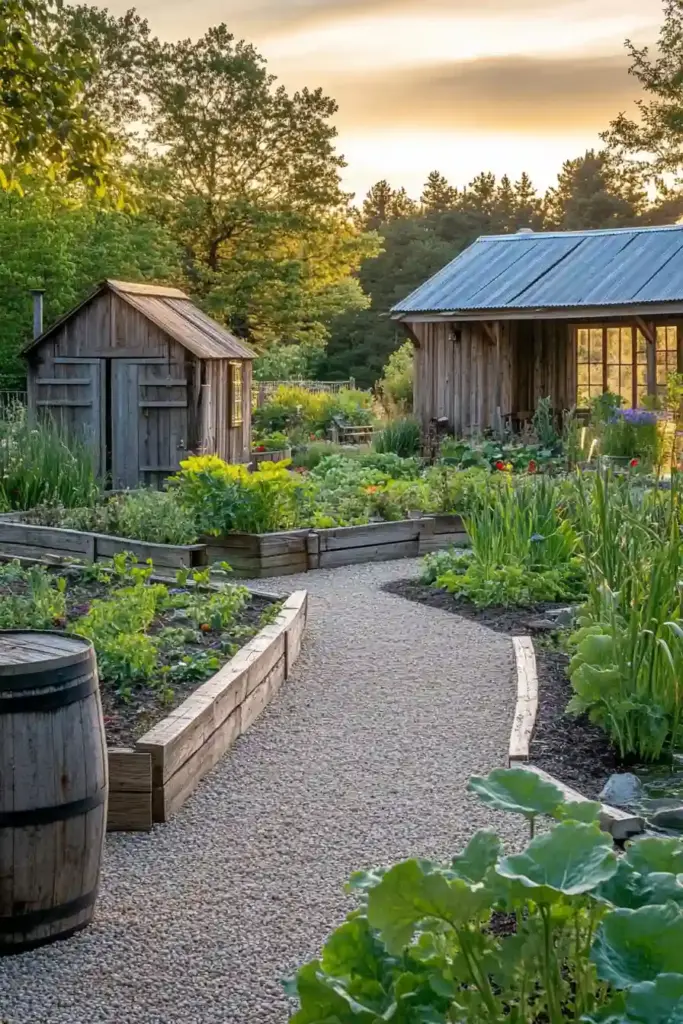
Creating clear paths not only boosts accessibility—it makes your space feel more intentional.
- Standard paths: 18” wide with mulch or gravel.
- Wheelchair/stroller-friendly: 36” wide with firm materials like decomposed granite.
- Edge paths with thyme or chamomile for a fragrant, pollinator-friendly border.
Raised Beds and Tiered Gardens: Level Up Your Yield
- Build 12” deep raised beds for root crops like carrots or beets.
- Use tiered beds on slopes to conserve water and prevent runoff.
- Paint or stain beds with non-toxic outdoor paint to match your home’s vibe.
Rainwater Harvesting & Small Water Features
Incorporate water elements to boost sustainability and create microclimates:
- A 50-gallon rain barrel can collect over 300 gallons of water a year from a 10×10 ft roof.
- Add a pond with water-loving plants (like taro or watercress) to attract beneficial wildlife and filter runoff.
- Install soaker hoses or drip irrigation for low-maintenance watering.
Backyard Farming Aesthetics: Beauty Meets Function

A thriving backyard farm doesn’t have to look like a utilitarian patch of dirt. With thoughtful design, it can be a serene, eye-catching oasis that reflects your personal style—while still producing baskets of fresh food.
Blend Form and Function: Make It Look as Good as It Works
- Trellis Art: Shape trellises into arches or spirals for visual impact. Let flowering vines climb for seasonal color.
- Painted Elements: Brighten rain barrels, compost bins, or coop doors with weatherproof acrylics in cheerful patterns.
- Decorative Coop Designs: Scalloped roofs and flower boxes can turn a basic chicken coop into a garden showpiece.
🌸 Pro Tip: Mosaic stepping stones made from tile scraps are a charming way to guide visitors between garden beds.
Color Coordination with Edibles and Ornamentals
Nature’s palette is more than green! Choose plant combinations that add depth, contrast, and year-round color.
- Cool Combinations: Pair red lettuce with blue borage or purple kale with yellow marigolds.
- Dual-Purpose Plants: Use variegated mint or rainbow chard for both flavor and flair.
- Winter Interest: Crimson-stemmed chard and evergreen herbs like rosemary provide structure in colder months.
Use Natural Materials for Rustic Charm
- Bed Edging: Border beds with fallen branches, bamboo, or river stones for an organic feel.
- Pergolas and Trellises: Build from salvaged wood to support grapevines or climbing squash.
- Clay Pot Ollas: Half-bury unglazed clay pots as self-watering planters—functional and decorative.
Garden Lighting: Extend the Magic After Sunset
Outdoor lighting transforms your backyard farm into an enchanting space for evenings and gatherings.
- Solar-Powered Lanterns: Line fences or pathways for soft, sustainable lighting.
- Path Lights: Install low-voltage fixtures to highlight garden borders.
- Hanging Mason Jar Candles: Perfect for fruit trees or trellises—adds a whimsical glow.
💡 Pro Tip: Add LED strip lights under raised beds to create floating garden effects at night.
Wildlife-Friendly Features: Invite Nature’s Helpers
Attract beneficial insects and birds to naturally protect your crops and pollinate your plants.
- Bee Hotels: Drill holes into wood blocks and place near flowering herbs.
- Butterfly Plants: Milkweed supports monarchs; native wildflowers draw pollinators.
- Birdbaths with Stones: Offer a shallow basin so small birds can drink without drowning risk.
DIY Backyard Farming Projects: Big Impact, Small Footprint
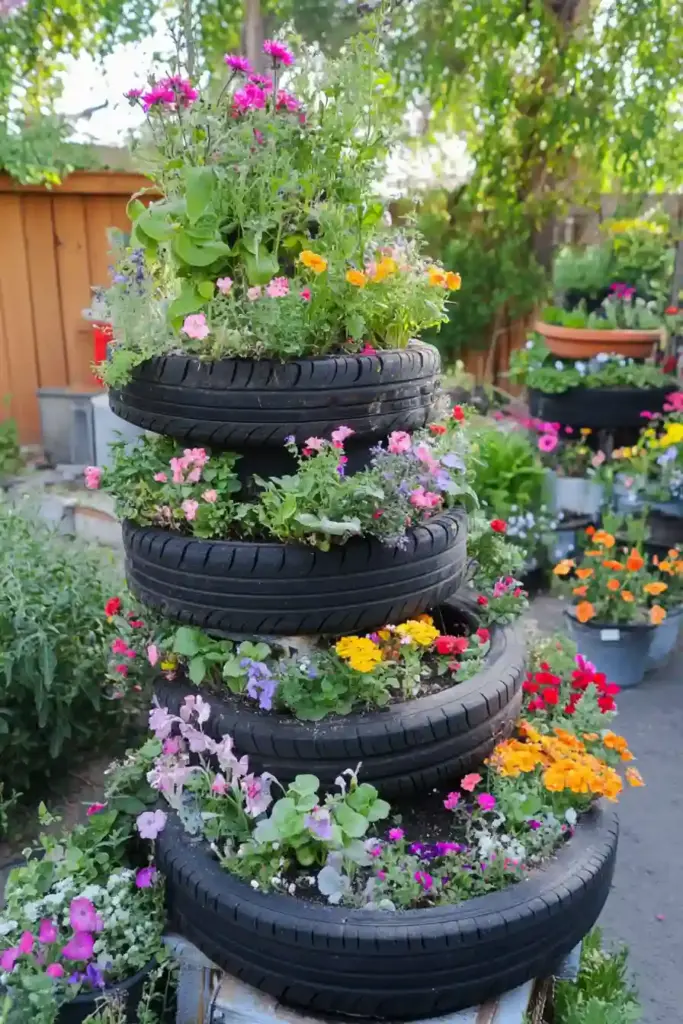
You don’t need a big budget (or a big yard) to make serious progress in backyard farming. With a little creativity and some upcycled materials, these DIY projects can boost your productivity, conserve resources, and add personality to your space.
Pallet Gardens: Vertical Greens on a Dime
Turn a discarded shipping pallet into an instant vertical garden.
- How-To:
- Sand the pallet and staple landscape fabric to the back and bottom.
- Fill each layer with soil.
- Plant herbs, lettuce, or strawberries in the slats.
- Placement: Lean it against a wall or fence for quick, vertical greenery.
🛠️ Pro Tip: Pallets labeled “HT” (heat treated) are safe to use—avoid “MB” (methyl bromide).
Tire Planters: Upcycle with Style
Old tires can be turned into colorful, circular planters—perfect for heat-loving crops.
- Paint with non-toxic exterior paint.
- Stack 2–3 high and drill drainage holes.
- Great for peppers, eggplants, and trailing flowers like nasturtiums.
♻️ Pro Tip: Plant trailing varieties along the edges for a “spilling” flower effect.
DIY Compost Bins: Black Gold on a Budget
Compost turns kitchen and garden waste into rich soil—no chemicals needed.
- Build a bin using four pallets nailed into a square frame.
- Layer greens (food scraps) and browns (leaves, paper) for balanced breakdown.
- Turn weekly, and harvest compost in about 3 months.
🐛 Bonus: Add red wiggler worms for faster decomposition!
Rain Barrels: Free Water for the Win
Harvesting rainwater is eco-friendly, free, and super useful for your plants.
- Convert a food-grade 55-gallon drum into a rain barrel by adding a spigot and mesh screen.
- Position it under a downspout to collect hundreds of gallons per year.
- Use with gravity-fed soaker hoses for efficient watering.
🌧️ Pro Tip: Paint barrels to match your garden aesthetic and prevent algae growth.
Upcycled Furniture: Quirky Planters with Personality
That old dresser or bookcase? Perfect planter material.
- Line drawers with burlap or landscape fabric and fill with soil.
- Plant shallow-rooted crops like lettuce or herbs.
- Prop drawers at an angle to create depth and interest.
🪑 Bonus: Use the top surface for a mini greenhouse or seed starting area!
Mini Greenhouses: DIY Climate Control
Protect seedlings from cold snaps or pests using simple materials:
- 2-Liter Cloche: Cut the bottom off a plastic bottle and place over young plants.
- Window Frame Greenhouse: Hinge two salvaged windows into an A-frame over raised beds.
🌡️ Pro Tip: Add vents (sticks or hinges) to prevent overheating on sunny days.
Beyond Vegetables: Perennials, Livestock Integration & Year-Round Resilience

While fast-growing crops are a great way to get started, adding perennials, small livestock, and preservation techniques creates a sustainable system that produces food for years with less effort over time.
Perennial Crops: Plant Once, Harvest for Years
Perennials are the backbone of any low-maintenance garden. Once established, they require less water, less effort, and offer consistent harvests.
- Dwarf Fruit Trees: Columnar apple and peach trees grow well in 15-gallon containers and yield 20–30 pounds annually.
- Berry Bushes: Thornless blackberries or blueberries grow along fences and can yield 10+ quarts each summer.
- Nut Trees: Hazelnuts or almonds are compact enough for small yards and begin producing in 3–5 years.
🌿 Guild Tip: Interplant beneficial crops like garlic around peach trees to repel borers, or strawberries under blueberries as edible ground cover.
Livestock Integration: Going Beyond Chickens
Compact livestock can support your ecosystem while feeding your family.
- Ducks: Lay more eggs than chickens and eat slugs and garden pests.
- Pygmy Goats: Excellent for clearing brush; their manure enhances compost piles.
- Bees: Top-bar hives (approx. 30″x18″) are easy to maintain and yield up to 50 pounds of honey annually.
🐝 Pro Tip: Always provide clean water within 10 feet of any livestock area. Consider rotational grazing or mobile pens for better land use.
Food Preservation: Eat Garden Goodness Year-Round
Preserving your harvest helps reduce waste and save money during off-seasons.
- Root Cellars: A 4×4 ft underground space can store carrots, potatoes, and onions at ~40°F for months.
- Dehydrating: Use hanging window screens or a solar dryer to preserve herbs and fruits.
- Fermenting & Freezing:
- Make sauerkraut, pickles, or kimchi in ceramic crocks.
- Blanch and freeze beans, peas, or greens in silicone bags.
🥫 Pro Tip: Start small with one preservation method, and expand based on your storage space and family needs.
Energy Efficiency: Low-Impact, Off-Grid Upgrades
Even small-scale homesteads can benefit from energy-saving tech:
- Solar Panels: A basic 200-watt panel can power irrigation timers, greenhouse fans, or chicken coop heaters.
- Rocket Mass Heaters: Built from cob and bricks, these use minimal wood to heat greenhouses or outdoor workspaces.
- Biogas Composting: Advanced setups can convert organic waste into methane to fuel outdoor stoves.
🔋 Pro Tip: Start by tracking your energy use (with a plug monitor or app) to identify where solar or passive systems can replace grid power.
Community Connections: Grow More Together
Sustainable homesteading thrives when neighbors collaborate.
- Seed Swaps: Exchange heirloom varieties, seedlings, or extra compost.
- Skill Shares: Teach and learn—offer a composting demo, and join a beekeeping workshop in return.
- Food Donations: Give extra produce or eggs to local food banks (check local health regulations first).
🌍 Pro Tip: Share your progress online or in community forums—it motivates others and builds a local knowledge network.
Final Thoughts: Start Small, Grow Big
Backyard farming proves that you don’t need acres of land—or a massive budget—to take control of your food supply, live more sustainably, and create something truly beautiful. Whether you start with a few herbs on a balcony, build a compost bin from pallets, or dream of keeping chickens and bees, each small step adds up to a more self-reliant lifestyle.
The key is starting simple: choose 2–3 manageable projects that fit your space and confidence level. Learn as you go, adapt to your environment, and remember—every tomato picked or egg collected is a step toward a healthier, more fulfilling life.
🌱 Keep a garden journal. Celebrate wins. Learn from the failures. And above all—keep growing.

